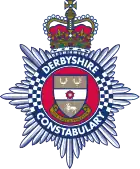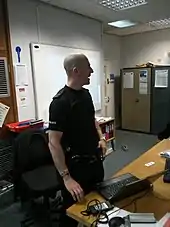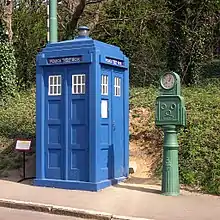| Derbyshire Constabulary | |
|---|---|
 | |
| Agency overview | |
| Formed | 1 April 1967 |
| Employees | 3,581[1] |
| Volunteers | 445[1] |
| Annual budget | £157.2 million[2] |
| Jurisdictional structure | |
| Operations jurisdiction | Derbyshire, England |
.svg.png.webp) | |
| Map of police area | |
| Size | 2,625 square kilometres (1,014 sq mi)2,625 km² |
| Population | 1 million |
| Legal jurisdiction | England and Wales |
| Constituting instrument | |
| General nature | |
| Operational structure | |
| Overviewed by | |
| Headquarters | Ripley |
| Constables | 1,827 [3] |
| Unsworn members | Community support officer 166[1] |
| Police and crime commissioner responsible | |
| Agency executive |
|
| Divisions | North, South, and Ops |
| Facilities | |
| Stations | 20
|
| Website | |
| www | |
Derbyshire Constabulary is the territorial police force responsible for policing the county of Derbyshire, England. The force covers an area of over 1,000 square miles (3,000 km2) with a population of just under one million.[4]
Organisation and structure

To police the county the force is divided into two territorial divisions, based respectively in the towns of Buxton and Chesterfield (North Division – covering High Peak and Derbyshire Dales District Council areas, Chesterfield, NE Derbyshire, Amber Valley and Bolsover and the villages of South Normanton and Pinxton which lie within the boundaries of Bolsover District Council), and Derby ( South Division – policing the city of Derby and the districts of Erewash, Long Eaton and South Derbyshire). The Force Headquarters, near Ripley and close to the A38 road, is Butterley Hall, former residence of Benjamin Outram and once owned by the Butterley Company.
The Old Hall and later additional buildings in the large grounds house much of the force's central administrative services. The Ops Divisions HQ at Wyatts Way Ripley (adjacent to force Headquarters) is now the home of Operational Support Division which encompasses the Road Policing Unit (with bases at Cotton Lane in Derby, Beetwell Street in Chesterfield and Chapel-en-le-Frith), ARU (Armed Response Unit), Dog Section, Uniform Task Force and Road Policing Support (Collision Investigators).

The Constabulary is led by the chief constable assisted by a Deputy and two assistant chief constables.[5] Each division is headed by a chief superintendent – the divisional commander – and each division is divided into Sections, which are led by an inspector. The force has an authorised establishment of 1,827 police officers,[6] 350 special constables and 104 Police Community Support Officers (PCSOs)[7]
The chief officers of the force formerly worked in partnership with the 17 publicly elected representatives on the Derbyshire Police Authority, which shared responsibility for budgets and policy, and was intended to ensure that the public of Derbyshire had a voice in the policing of their county. Since the introduction of the Police Reform and Social Responsibility Act 2011 the Derbyshire Police and Crime Commissioner (PCC) is now responsible for tasks that were once completed by the Police Authority. In November 2012, Alan Charles was elected as PCC for a four-year term. Charles previously served as Vice Chair of the Derbyshire Police Authority.
PEEL inspection
His Majesty's Inspectorate of Constabulary and Fire & Rescue Services (HMICFRS) conducts a periodic police effectiveness, efficiency and legitimacy (PEEL) inspection of each police service's performance. In its latest PEEL inspection, Derbyshire Constabulary was rated as follows:[8]
| Outstanding | Good | Adequate | Requires Improvement | Inadequate | |
|---|---|---|---|---|---|
| 2021/22 rating |
|
|
Geography and demographics

Derbyshire Constabulary polices an area which ranges from remote rural locations to busy city-centre and suburban environments. The more urbanised east and south of the county, including the market town of Chesterfield and the city of Derby, generally require more officers to respond to the needs of the large resident population, while the more rural north and west require the smaller number of officers to be more mobile. Calls for service in the rural areas usually increase during summer as the population is boosted by approximately twenty million visitors each year to the Peak District and its surrounds. Winter weather on the unforgiving high ground around Glossop and Kinder Scout can also cause problems for traffic and residents.
Regionalisation
Proposals were made by the Home Secretary on 20 March 2006 to integrate groups of police forces in England and Wales into 'strategic' forces, which he saw as being more 'fit for purpose' in terms of combating terrorism and organised crime. Under these proposals Derbyshire would have merged with nearby forces to create an 'East Midlands Police'.[9] However, these proposals were unpopular and were later cancelled.
History
In 1965, the force had an establishment of 852 and an actual strength of 775.[10]
Chief Constables
- 1873–unknown: Francis Joseph Parry
- 1876–1898: Lieutenant-Colonel William Addis Delacombe[11]
1898–unknown: Capt. Henry Mansfield Haywood[12]
- 1918–c. 1927: Major Philip Francis Ross Anley
- 1954–1967: William Ewart Pitts
- 1967–1979: Sir Walter Stansfield[13] (knighted 1979 New Year Honours)
- 1979–1981: James Fryer
- 1981–1985: Alfred Parrish
- 1985–1990: Alan Smith
- 1990–2000: John Newing
- 2001–2007: David Coleman
- 2007–2017: Mick Creedon
- 2017–2020: Peter Goodman
- 2020–present: Rachel Swann
Officers killed in the line of duty
The Police Roll of Honour Trust and Police Memorial Trust list and commemorate all British police officers killed in the line of duty. Since its establishment in 1984, the Police Memorial Trust has erected 50 memorials nationally to some of those officers.
Since 1828 the following officers of Derbyshire Constabulary were killed while attempting to prevent or stop a crime in progress:[14]
- Parish constable William Taylor, 1828 (fatally injured arresting two men)
- Police constable Joseph Moss, 1879 (shot whilst dealing with a prisoner)
- Police constable Stevenson, 2013 (collapsed and died while on duty)
See also
- Law enforcement in the United Kingdom
- List of law enforcement agencies in the United Kingdom, Crown Dependencies and British Overseas Territories
- North Midlands Helicopter Support Unit (now defunct)
- Murder of Barbara Mayo, infamous unsolved murder of a woman in 1970 which Derbyshire Constabulary was responsible for investigating
References
- 1 2 3 "Derbyshire | Home Office". Archived from the original on 5 May 2009. Retrieved 22 February 2009.
- ↑ "Derbyshire Police – news". Archived from the original on 5 August 2008. Retrieved 10 April 2008.
- ↑ "Tables for 'Police workforce, England and Wales, 31 March 2013". HM Government. Office for National Statistics. 31 March 2013. Retrieved 29 May 2014.
- ↑ "Derbyshire Police". Retrieved 16 August 2012.
- ↑ Deputy Chief Constable Rachel Swann appeared on BBC TV News in August 2019 sporting a 'Jedward style haircut
- ↑ "Tables for 'Police workforce, England and Wales, 31 March 2013". HM Government. Office for National Statistics. 31 March 2013. Retrieved 29 May 2014.
- ↑ Archived 5 February 2007 at the Wayback Machine
- ↑ "PEEL 2021/22 Police effectiveness, efficiency and legitimacy: An inspection of Derbyshire Constabulary" (PDF). His Majesty's Inspectorate of Constabulary and Fire & Rescue Services. 25 November 2022. Retrieved 2 December 2022.
- ↑ "Police forces 'to be cut to 24'". BBC News. 20 March 2006. Retrieved 3 March 2011.
- ↑ The Thin Blue Line, Police Council for Great Britain Staff Side Claim for Undermanning Supplements, 1965
- ↑ "Obituary – Lt-Col Delaombe". The Times. No. 36861. London. 1 September 1902. p. 4.
- ↑ The Justice of the Peace, 12 February 1898
- ↑ Clark, Chris (28 January 2014). "List Of Senior Officers 1970-1985". WhatDoTheyKnow/Derbyshire Constabulary. Retrieved 31 July 2018.
- ↑ "Police Roll of Honour Trust". policememorial.org.uk.